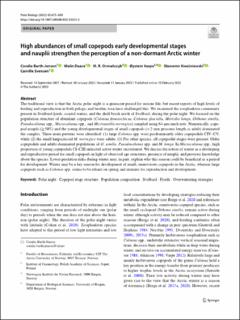| dc.description.abstract | The traditional view is that the Arctic polar night is a quiescent period for marine life, but recent reports of high levels of feeding and reproduction in both pelagic and benthic taxa have challenged this. We examined the zooplankton community present in Svalbard fjords, coastal waters, and the shelf break north of Svalbard, during the polar night. We focused on the population structure of abundant copepods (Calanus finmarchicus, Calanus glacialis, Metridia longa, Oithona similis, Pseudocalanus spp., Microcalanus spp., and Microsetella norvegica) sampled using 64-µm mesh nets. Numerically, copepod nauplii (≥ 50%) and the young developmental stages of small copepods (< 2 mm prosome length as adult) dominated the samples. Three main patterns were identified: (1) large Calanus spp. were predominantly older copepodids CIV–CV, while (2) the small harpacticoid M. norvegica were adults. (3) For other species, all copepodid stages were present. Older copepodids and adults dominated populations of O. similis, Pseudocalanus spp. and M. longa. In Microcalanus spp., high proportion of young copepodids CI–CIII indicated active winter recruitment. We discuss the notion of winter as a developing and reproductive period for small copepods in light of observed age structures, presence of nauplii, and previous knowledge about the species. Lower predation risks during winter may, in part, explain why this season could be beneficial as a period for development. Winter may be a key season for development of small, omnivorous copepods in the Arctic, whereas large copepods such as Calanus spp. seems to be reliant on spring and summer for reproduction and development. | en_US |

